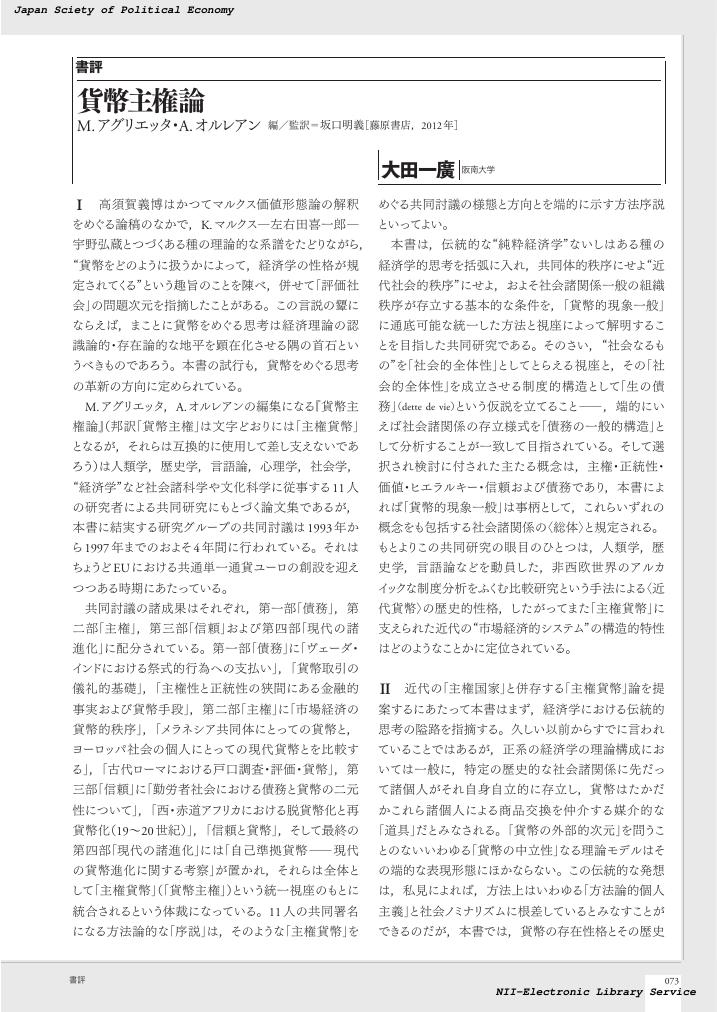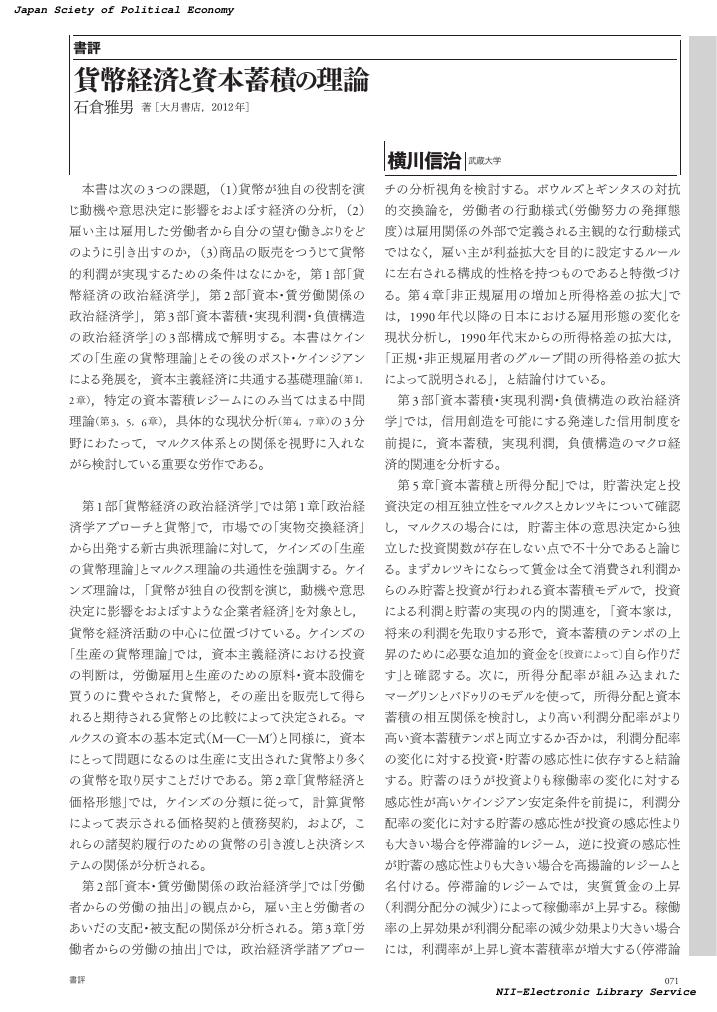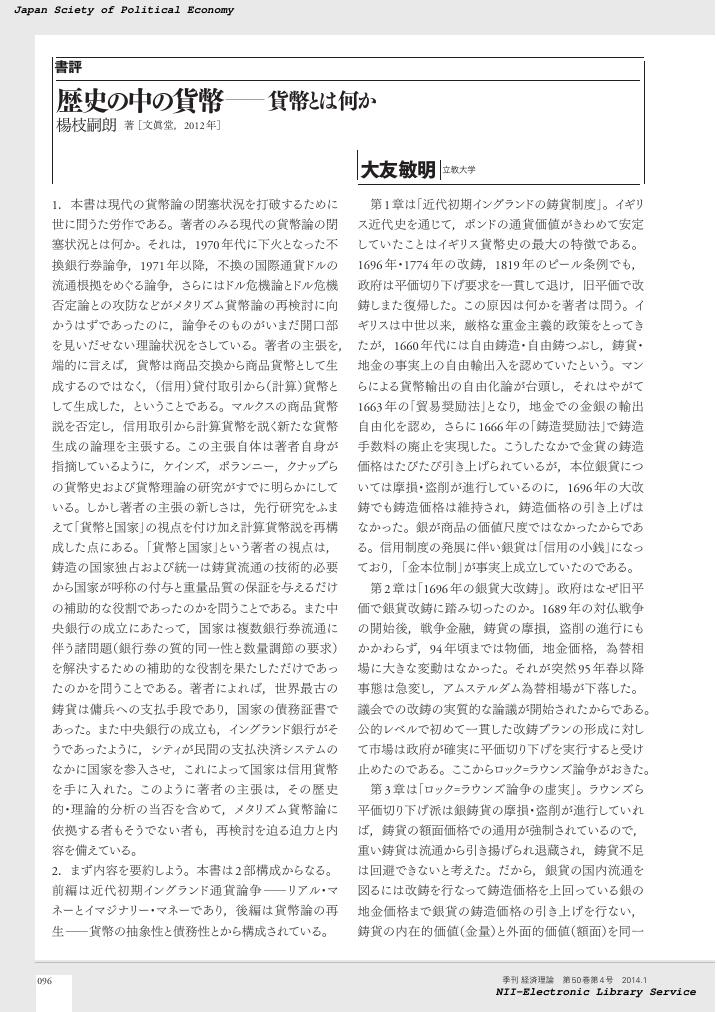1 0 0 0 OA 『資本論』解釈としてのNew Interpretation
- 著者
- 森本 壮亮
- 出版者
- 経済理論学会
- 雑誌
- 季刊経済理論 (ISSN:18825184)
- 巻号頁・発行日
- vol.51, no.3, pp.54-64, 2014-10-20 (Released:2017-04-25)
This paper examines Dumenil and Foley's "New Interpreta-tion(NI)" of Marx's value theory as an interpretation of Capital. We can summarize the NI as follows. First, it bridges the dimensions of labor values and prices by the concept of the "value of money," which is defined as the ratio of aggregate labor time to aggregate money value added. Second, it interprets Marx's value theory as a macroeconomic labor theory and the equality between total value and total price as the net one in a given period. Third, it defines the value of labor power as the money wage multiplied by the "value of money," and argues that exploitation is an issue of the distribution of the net value added between workers and capitalists. Although Dumenil and Foley claim that the NI is just what Marx tried to argue in Capital, Marx's texts and manuscripts of Capital show the opposite. Marx's starting point was to criticize classical economists who explained that wage was a proportion of the net value added and exploitation was a distributional issue. The argument of the NI is totally the same with the one of classical economists. In contrast, Marx argues that the capitalist exploitation is for workers to be absorbed into the circuit of capital whose sole aim is to increase the value. Also Marx points out that variable capital, which is used for wage, is the value that workers created not in the present but in the past. These Marx's arguments show that Marx's value theory is quite similar to the "temporal single-system interpretation (TSSI)." Therefore the orthodox(or Sraffian)interpretation of Marx's value theory and the transformation problem is also invalid as an interpretation of Marx. First, although the orthodox interpretation claims that Marx considers exploitation as an issue of the distribution of labor for production, Marx doesn't. Marx's exploitation theory is constructed based on the concept of the circuit of capital, and it is irrelevant to the distribution of labor for production. Second, although the orthodox interpretation claims that the dimension of the transformation is labor time, such claim is both unrealistic and alien to capitalism. Capitalists'criteria are their rates of profit or amounts of profit, not their "rates of profit" of labor time. There is no reason for such "rates of profit" to be uniformed at least in a capitalist society. Thus we conclude that the most appropriate new interpretation of Marx's Capital is the TSSI.
- 著者
- 岩田 佳久
- 出版者
- 経済理論学会
- 雑誌
- 季刊経済理論 (ISSN:18825184)
- 巻号頁・発行日
- vol.52, no.3, pp.77-88, 2015-10-20 (Released:2017-09-19)
It is well known that there are two opposed views of the asset price rising, Fed view and BIS view. Fed view advocates "Clean up the mess" strategy, which leaves the asset price rising and eases credit boldly in the burst of the bubble. On the other hand, BIS view advocates "Lean against the wind" strategy, which tightens credit proactively at the asset price rising. The opposition between the two views also exists in the debate of Global Imbalances in the 2000s. Bernanke, Fed view, argues that "Global saving glut" flows into US and makes the current account deficit (i.e. net capital inflow) larger in US and the interest rate lower in the world. On the other hand, Borio, BIS view, objects that the excess savings in national economic accounting system is irrelative to the bank ability to expand credit and to set the interest rate, and that what is influential on the asset price rising is not net capital inflow but gross one. Borio's argument is superior to Bernanke on the financial economy, but has some weaknesses when it is reviewed from the point of the Marxian economics. This paper tries to develop the Marxian credit theory. Firstly, Borio accepts the concept of ex ante saving and investment though he thinks little of it in determination of the market interest rate. As we can see in the debate between Keynes and Ohlin in 1937, ex ante saving is not lending the saving but financing the investment by the credit creation. Secondly, Borio emphasizes that money (credit money) is made by credit creation from nothing, ex nihilo. But, though the recent Marxian economics also accepts that money is created by the banks, it emphasizes that credit money anticipates the reflux of money in the future. Credit money is backed by the value of commodity or the ability to gain money, such as the labor's ability to gain wage and the government's ability to collect tax. That is, credit money is not created from nothing, but based on the value of commodities or on the ability to realize the value in the future. Thirdly, the interest rate is determined at the level where banks can gain the average profit. Marx explained the level of interest rate from the relation between demand and supply of money capital. But the bank, as a capital, self-valorizing value, gains the general profit rate on the invested capital through the competition in the same sector and among the all sectors.
1 0 0 0 反緊縮のマクロ経済政策理論 (特集 政治経済学の経済政策論)
- 著者
- 松尾 匡
- 出版者
- 経済理論学会事務局 ; 2004-
- 雑誌
- 季刊経済理論 (ISSN:18825184)
- 巻号頁・発行日
- vol.54, no.4, pp.14-26, 2018-01
1 0 0 0 OA 家事労働とマルクス剰余価値論, 森田成也著, [桜井書店, 2014年]
- 著者
- 佐藤 拓也
- 出版者
- 経済理論学会
- 雑誌
- 季刊経済理論 (ISSN:18825184)
- 巻号頁・発行日
- vol.52, no.4, pp.95-97, 2016-01-20 (Released:2018-01-09)
- 著者
- 佐藤 秀夫
- 出版者
- 経済理論学会
- 雑誌
- 季刊経済理論 (ISSN:18825184)
- 巻号頁・発行日
- vol.52, no.2, pp.107-109, 2015
- 著者
- 宮川 彰
- 出版者
- 経済理論学会
- 雑誌
- 季刊経済理論 (ISSN:18825184)
- 巻号頁・発行日
- vol.51, no.2, pp.31-41, 2014-07-20
The core of progress in the formative history of Das Kapital the second volume during Marx's last years was when he reached his ultimate critique about "Smith's Dogma", classical reproduction theory, by finishing the theory of circuits of capital, and developed an original new paradigm on the theory of reproduction. Until the second manuscript(1868-1870) he could not overcome the concept of capital-revenue transformation and resolve the value-theory of the classical school so his discussion was limited within the framework of the means of consumption sector-led dogma that has the stand point of a money-veil view, but by finishing 5-7 manuscripts of the circuits of capital in late 1870', he made the discovery of multilayered ties between capital(/revenue) and general commodity circulation, as well as a mutual relationship between money-capital and money. Furthermore, he found that capital itself circulates and by this(working as a lever) he could finally overthrow the classical theory of reproduction based on dogma and achieve the accomplishment of establishing his original theory, the theory of reproduction based on the circuits of capital. In the discussion of formative history for the second volume, the evaluation of Marx's step regarding the theory of reproduction, 2 conflicting opinions between the one way of "understanding of manuscripts in gradual consistency" and the other way of "grasping of a drastic theoretical development" are rekindled. It depends on how the process is seen but the fact is that Marx clearly denied his former way of understanding the classical concept of capital-revenue transformation and of resolving the theory of value Dogma. In this report, using clues from the publication of drafts of the MEGA second section 11^<th> volume, the 8^<th> manuscript was found to be the watershed in which it can clearly be seen how Marx overcame the dictates of classical Dogma and, as a result, it can be concluded "the grasping a final drastic development in the 8^<th> manuscript" is correct.
1 0 0 0 知られざるマルクス : メガが今日までにマルクスの著作についてわれわれに語ったこと、メガ以前にわれわれが知らなかったこと(<特集>『資本論』草稿研究の現在-新メガの編集・刊行とその成果)
- 著者
- クレトケ ミヒャエル・R 竹永 進
- 出版者
- 経済理論学会
- 雑誌
- 経済理論 (ISSN:18825184)
- 巻号頁・発行日
- vol.42, no.4, pp.34-44, 2006
The second MEGA, starting in the 1970s, has provided access to quite a lot of hitherto unknown and unpublished writings by Marx and Engels. It has allowed us to discover an unknown Marx, in particular with respect to his unfinished masterpiece, Capital. Because of the many manuscripts pertaining to this great project that have been published in recent years, we are now able to assess the long road that led towards what we know as Capital in much detail. As a matter of fact, Marx did actually write no less than four different versions of his critique of political economy, starting in 1857/58. When he died in 1883, he was not yet finished with it. We are also able to follow Marx' revising and rewriting of Capital, volume I from the first German edition of 1867 until the 3^<rd> German edition of 1883, which had still been largely prepared by Marx himself, Capital remained largely a work in progress. Thanks to the materials that already have been published or will be published in the years to come, we are now able to get a clear idea of Marx' work on Capital during the last 15 years of his life, when, as conventional wisdom has it, he seemed to have lost track of his great project. On the contrary, the evidence shows that he continued to work on it until his last days. Recently, Engels' work as editor of Marx' manuscripts for Capital, volume II and III, has been criticized harshly, once the original manuscripts for volume II and III of Capital had been published. As more of Engels' redaction manuscripts have been or are about to be published in the MEGA, we are now able to reassess Engels' work-and to refute most of the criticism as rather exaggerated.
- 著者
- 鶴田 満彦
- 出版者
- 経済理論学会
- 雑誌
- 経済理論 (ISSN:18825184)
- 巻号頁・発行日
- vol.51, no.3, pp.90-92, 2014
- 著者
- 小倉 将志郎
- 出版者
- 経済理論学会
- 雑誌
- 季刊経済理論 (ISSN:18825184)
- 巻号頁・発行日
- vol.48, no.4, pp.98-100, 2012-01-20 (Released:2017-04-25)
- 著者
- 佐藤 隆
- 出版者
- 経済理論学会
- 雑誌
- 季刊経済理論 (ISSN:18825184)
- 巻号頁・発行日
- vol.51, no.4, pp.96-98, 2015
1 0 0 0 OA 改めて,私たちは市場とどのように向き合うべきか(<特集>調和する社会の諸相)
- 著者
- 佐藤 良一
- 出版者
- 経済理論学会
- 雑誌
- 季刊経済理論 (ISSN:18825184)
- 巻号頁・発行日
- vol.50, no.3, pp.20-30, 2013-10-20 (Released:2017-04-25)
The difference of the idea in economics stems from the approach to the question: how to answer the mechanism of a market. The financial crisis in 2008 could be interpreted as the end of 'Market fundamentalism', however, the situations has been almost the same before the crisis. The 'market' is still the subject when businessmen talk about the economic problems. We have to tackle with the fundamental question: what is the core for ordinary people who sell labor-power for their subsistence. This paper consists as follows. In section I the argument of 'How market crowd out morals' by Sandel, the critics by Bowels and Gintis, and the reply to them are introduced. Needless to say, the fundamental unit, which organizes a society, should be a human being. The hypothesis on its behavior is indispensable for an economic theory. Neoclassical theory adopts the assumption of so-called homo-economicus. An alternative to this is 'Reciprocans', which is presented by US radicals. The distinction between these two is examined in the section II. When we try to present an alternative to the status quo from the viewpoint of 'a harmonious society', the development of the situation must be confirmed correctly. The recent change of the wage share in the US shows the severe conditions for working people. Assuming the capitalist way of management, the fundamental relations between capital and labor cannot be harmonious but conflict. As a Keynes model teaches us, the real wage rate must be reduced when the capitalist increase the employment. Profit maximization can be satisfied when the real wage rate is equal to the marginal product of labor. According to this condition, the inverse relation between an employment and real wage holds. Regrettably new prospects for an alternative won't be opened unless we could succeed in making some drastic change. If we pursue the harmony among people, the point is the feasibility of an alternative and the potential path to a 'new society'. For the present, we have to take a realist view of 'capitalist' economy. This means that we have to change the capitalist way of management step by step(section III).
- 著者
- 大田 一廣
- 出版者
- 経済理論学会
- 雑誌
- 季刊経済理論 (ISSN:18825184)
- 巻号頁・発行日
- vol.50, no.3, pp.73-75, 2013-10-20 (Released:2017-04-25)
- 著者
- 二宮 健史郎
- 出版者
- 経済理論学会
- 雑誌
- 季刊経済理論 (ISSN:18825184)
- 巻号頁・発行日
- vol.46, no.4, pp.25-33, 2010-01-20 (Released:2017-04-25)
There has been antagonism between neo-classical and Keynesian macroeconomics since the 1980s. Neo-classical economists have criticized the IS-LM model for reasons such as lacking a microeconomic foundation and assuming price stickiness. Neo-classical and Keynesian economics also hold differing theories of interest rate. In short, neo-classical economics adopts the saving-investment theory of interest rate determination, whereas Keynesian macroeconomics adopts the liquidity preference theory. Mankiw (1992) proposed a macroeconomic model in the short and long run. He interpreted the IS equation as the saving-investment theory of interest rate and the LM equation as the quantity theory of money. Romer (2000) and Taylor (2004) presented another macroeconomic model in which a monetary policy rule was introduced in place of the LM equation. Romer (2000) and Taylor (2004) abandoned any differing theory of interest rate between neo-classical and Keynesian economics. On the other hand, Minsky (1982; 1986) who was a heavyweight in post-Keynesian economics proposed the financial instability hypothesis, which emphasized how the complicated financial structure underlying the capitalist economy generates business fluctuations and cycles. Many non-neo-classical economists have developed his idea following Taylor and O'Connell (1989) who proved that an economy would fall into a financial crisis when a decline in expected profit rates aggravated the financial condition of firms and increased households' preference for liquidity. Recent studies by Asada (2006) and Ninomiya and Sanyal (2009) have incorporated the dynamic equation of debt burden of firms into nonlinear economic dynamic models to indicate the financial condition. Following Rose (1969) and Okishio (1986), Ninomiya (2007c) adopted the loanable fund theory and discussed financial instability in an oligopolistic (or short run) economy. This paper examines financial instability in macroeconomics in the short and long run. We adopt the loanable fund theory to integrate neo-classical and Keynesian economics in order to evaluate the post-Keynesians' analysis of financial instability.
1 0 0 0 OA 金融危機下の日銀の金融政策, 建部正義著, 中央大学出版部, 2010年
- 著者
- 前畑 雪彦
- 出版者
- 経済理論学会
- 雑誌
- 季刊経済理論 (ISSN:18825184)
- 巻号頁・発行日
- vol.48, no.1, pp.86-88, 2011-04-20 (Released:2017-04-25)
- 著者
- 建部 正義
- 出版者
- 経済理論学会
- 雑誌
- 季刊経済理論 (ISSN:18825184)
- 巻号頁・発行日
- vol.51, no.3, pp.101-104, 2014-10-20 (Released:2017-04-25)
1 0 0 0 OA 21世紀型世界経済危機と金融政策, 建部正義著, [新日本出版社, 2013年]
- 著者
- 米田 貢
- 出版者
- 経済理論学会
- 雑誌
- 季刊経済理論 (ISSN:18825184)
- 巻号頁・発行日
- vol.50, no.4, pp.117-120, 2014-01-20 (Released:2017-04-25)
1 0 0 0 OA 貨幣経済と資本蓄積の理論, 石倉雅男著, 大月書店, 2012年
- 著者
- 横川 信治
- 出版者
- 経済理論学会
- 雑誌
- 季刊経済理論 (ISSN:18825184)
- 巻号頁・発行日
- vol.51, no.1, pp.71-73, 2014-04-20 (Released:2017-04-25)
- 著者
- 植村 博恭
- 出版者
- 経済理論学会
- 雑誌
- 季刊経済理論 (ISSN:18825184)
- 巻号頁・発行日
- vol.52, no.1, pp.4-21, 2015-04-20 (Released:2017-04-25)
In order to reconstruct the economic theory, we should develop our study on the basis of existing achievements with an intentionally refreshed methodological approach. We have developed "the institutional analysis of socio-economic systems" which integrates the regulation theory, the Post-Keynesian theory and the Radical Economics theory. We have also developed collaborative researches with the various economics of institutions and evolution, and have published books such as the Japanese version of S. Bowles's Microeconomics: Behavior, Institutions and Evolution as well as R. Boyer, H. Uemura, and A. Isogai (eds.) Diversity and Transformations of Asian Capitalisms. The aim of this paper is to investigate how we can reconstruct the economic theory, surveying and assessing the results of our collaborative researches from the theoretical point of view. We especially focus on following points. First, the methodology of this theoretical investigation is proposed, while referring to E. Sugimoto'concept of "modern economics" to emphasize the importance of productive academic discussion. Furthermore, it is pointed out that productive discussions have not been promoted due to the dominance of "the Neo-Classical paradigm". Second, after investigating the basic assumptions of the Neo-Classical paradigm, the academic significance and intrinsic theoretical problems of Marx and Keynes are considered, and it is shown how the Post-Marxian and the Post-Keynesian have tried to overcome their problems. Third, based on the recent development of the economics of institutions and evolution, we show our own research agendas on following subjects: mutually determining relations between institutions/macro processes and the behaviors of agents, meso-level coordinating mechanisms, relationships between the financial system and wage-labor nexus, the institutional varieties of capitalism. Fourth, the recent studies of price and wage determination, the financial system and international trade in contemporary capitalism are assessed thoroughly, and the new achievements of researches by the regulation theory and the contemporary Classical trade theory are studied to reconstruct the economic theory.
1 0 0 0 OA 歴史の中の貨幣-貨幣とは何か, 楊枝嗣朗著, [文眞堂, 2012年]
- 著者
- 大友 敏明
- 出版者
- 経済理論学会
- 雑誌
- 季刊経済理論 (ISSN:18825184)
- 巻号頁・発行日
- vol.50, no.4, pp.96-98, 2014-01-20 (Released:2017-04-25)
1 0 0 0 OA 資本主義の成熟と転換-現代の信用と恐慌, 小西一雄著, [桜井書店, 2014年]
- 著者
- 建部 正義
- 出版者
- 経済理論学会
- 雑誌
- 季刊経済理論 (ISSN:18825184)
- 巻号頁・発行日
- vol.52, no.2, pp.110-112, 2015-07-20 (Released:2017-07-03)









